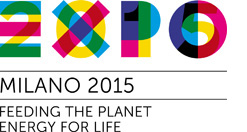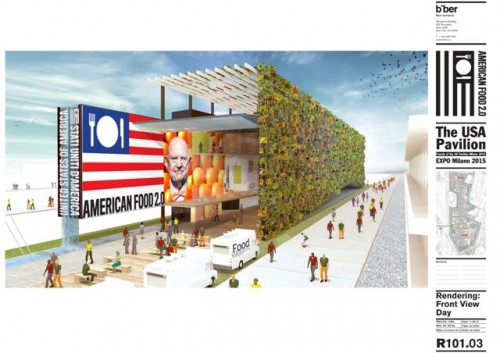
As the opening of Milan Expo 2015 drew closer, James Ogul looked back at another world’s fair in Italy, held in 1992. Genoa ’92 was an International Specialized Expo sanctioned by the Bureau of International Expositions (BIE). It ran May 15-August 15 and its theme was “Christopher Columbus: Ships and the Sea.”
Image at top: rendering of the USAP at Expo Milano 2015.
This article, originally published in December 2013, is part of “Tales from the Expo” – an InPark Magazine online book written by James Ogul and edited by Judith Rubin.
[dropcap color=”#888″ type=”square”]L[/dropcap]ocated one hour and 46 minutes from Milan by car, the Genoa event did not gain much attention because there were two world’s fairs in 1992, both in Europe. The larger of them was Seville ’92 (Spain).
Funding for the US pavilion in Genoa was $2.9 million with a 50/50 Federal-private sector split. The Federal funds were secured through a protracted negotiation with Congress that resulted in a reprogramming request. The major private sector sponsor for the pavilion was Amway Corporation.
Exhibitors at Genoa were housed for the most part in a restored cotton warehouse although the US opted to set up in one of four adjacent buildings that had been 17th century merchant homes called palazzine. The 5,000-square-foot US exhibit made use of media effects in three galleries to depict the importance of waterways to US history, development and traditions. The Chesapeake Bay and the port of Baltimore, a sister city of Genoa were singled out as illustrative of American maritime culture. The exhibit also emphasized the need to preserve and protect the world’s waterways.
Getting back to the present, the 2015 Universal Expo in Milan will run May 1-October 31, 2015. Its theme is “Feeding the Planet, Energy for Life.” Attendance is projected at 20 million visitors. In comparison, Genoa ’92 was very small: it occupied 12 acres and had 52 international exhibitors to Milan’s 271 acres and 140+ participating nations.
Likewise, the US pavilion at Milan 2015 will be much larger and a more elaborate undertaking, built from the ground up on a 2,790 square meter site, unlike Genoa where the organizers leased space within an existing building. The cost of participation will be commensurately higher: an estimated $45 million. The funding challenge is also now significantly different for a US pavilion compared to 1992: All of that $45 million will have to be raised from private sector contributions.
Charles Faas is CEO of the official US pavilion project being created by “Friends of the US Pavilion Milano 2015” – the private sector team acting on the authority of a Letter of Intent from the US State Department. Members of this group include Dorothy Hamilton, CEO of the International Culinary Center; Mitchell Davis, VP of The James Beard Foundation; and Simone Crolla, managing director of the US Chamber of Commerce in Italy.
Once the Friends group has demonstrated that all funding for this project will be in hand, they will sign a Memo of Understanding with the State Department, which will then sign a Participation Contract with the Expo Organizers, and appoint a Commissioner General.
This has been the US pattern for the past three world expos – Aichi 2005, Shanghai 2010 and Yeosu 2012. Only after the US has signed a Participation Contract with the Expo Organizers will the US plot be turned over to the US and the Friends group be able to break ground for the Pavilion.

Obviously the sooner all of this can take place the better to allow time for building construction. Construction must be completed well before opening day to allow time for installation of exhibits.

The compressed timeframe for this effort is due in large part to the lateness of the US decision to participate. Unfortunately this has been true for most of the expos in recent history. No appropriations for world’s fair participation have been received since 1988. Further, the office charged with handling these projects was abolished in 1993. So often it has been a high level appeal from the host country that has triggered a decision and this has happened only after all other avenues have failed. And so we have been late, and with less time to do the work, costs and risks have risen.
Notwithstanding these challenges, the US had very successful pavilions at Aichi ’05, Shanghai Expo ’10 and Yeosu ’12. This was accomplished through dedicated Federal and private sector partners working cooperatively to pull these projects together in record time. Challenges abound in complex projects like these and there are constant struggles to meet budget requirements and milestones. Having spent hundreds of hours on the exhibition floors of our US Pavilions and watching visitor reaction and interaction with both our exhibits and our guides, I can say that all of the efforts that go into them are very worthwhile.







